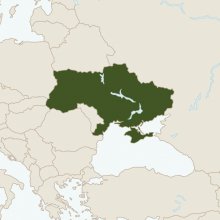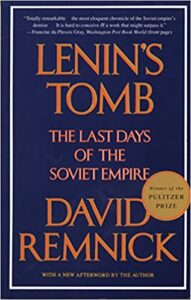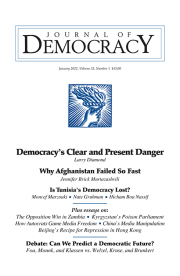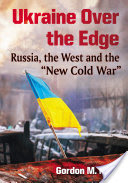Can Russia’s aggression be explained by Kremlin fears that a prosperous Ukraine could become a model for Russia’s opposition?
While the West’s strategy has shifted the initial calculus for Russia and negated Moscow’s ability to surprise, it has come at the cost of broadcasting to a global audience its divisions on how to handle Russia, The FT’s Henry Foy observes:
“Aggressors usually like to have a pretext for war, and the Americans going public have made that more difficult,” said Radoslaw Sikorski, who was Polish foreign minister during Russia’s war with Georgia in 2008 and invasion of Crimea in 2014. “[But] it has made it more difficult for us too because it exposed for all to see how disjointed the west is . . . exposing an impression of western disarray, which goes back years,” added Sikorski, who is now a member of the European parliament.

NDI
The last few weeks have been immensely beneficial for the Putin regime, NRC Handelsblad’s Caroline de Gruyter writes for Foreign Policy:
- First, Putin has grabbed the initiative and the headlines. He has reminded the world and his own subjects of what he can do if he wants to. He can invade Ukraine if he desires, the proof of that being how fearful the West is of Putin doing so. For a regime relying so much on force, internally and abroad, such confirmation by its so-called enemies is very significant.
- Then, by moving his troops close to the Ukrainian border, Putin has sent shockwaves throughout Europe and the United States, prompting discussions on how they would react should he indeed invade Ukraine. Sanctions would probably be imposed, as they were before. But the main conclusion Moscow would draw from these discussions is that the West is divided. Instead of producing strong deterrence, the West has done little more than reveal cracks everywhere….
- Putin has also won the day by showing Ukraine and other ex-Soviet satellites tempted by or in an alliance with the West that their Western allies are weak and indecisive in the face of existential threats. The West would convene urgently, discuss sanctions, perhaps even impose them like they did after Russia’s previous Ukraine invasion—but nothing more.
 Maintaining a common transatlantic response could prove more complex should Putin’s next moves against Ukraine fall short of a full invasion that drives toward Kyiv, says Daniel Fried, the Weiser Family distinguished fellow at the Atlantic Council. Smaller moves by Russia are likely to trigger a debate about what a “proportional”—that is to say, weaker—response might involve.
Maintaining a common transatlantic response could prove more complex should Putin’s next moves against Ukraine fall short of a full invasion that drives toward Kyiv, says Daniel Fried, the Weiser Family distinguished fellow at the Atlantic Council. Smaller moves by Russia are likely to trigger a debate about what a “proportional”—that is to say, weaker—response might involve.
Still more complex would be a limited Russian incursion followed by “peace proposals” that reduced current maximalist Russian demands but still insisted on things such as closing NATO’s “open door” to countries like Ukraine. Would EU member states start to break ranks in such a scenario? I remain optimistic that they won’t, but we shall perhaps soon see my optimism tested, notes Fried, a National Endowment for Democracy (NED) board member.
As the United States continues to pursue diplomacy amid a Russian military build-up near Ukraine’s borders, recent developments have put NATO’s ability to present a united front in question, Foreign Policy’s Colm Quinn adds:
On Friday, it emerged that Germany was blocking NATO ally Estonia from transferring German-origin howitzer artillery to Ukraine, while off-the-cuff remarks from Germany’s navy chief Kay-Achim Schönbach—saying that Crimea would not return to Ukraine and that Russian President Vladimir Putin deserved respect—forced his resignation over the weekend…. German officials have privately said they are ready to shelve Nord Stream 2, a gas pipeline direct from Russia to Germany, in the event of Russian military action, although such a threat has yet to be made explicitly.
 Over and over, Putin has learned a singular lesson: crowds rarely come to the public square demanding more autocracy, says The New Yorker’s David Remnick, author of “Lenin’s Tomb: The Last Days of the Soviet Empire:”
Over and over, Putin has learned a singular lesson: crowds rarely come to the public square demanding more autocracy, says The New Yorker’s David Remnick, author of “Lenin’s Tomb: The Last Days of the Soviet Empire:”
Ukraine is a sovereign nation of more than forty million people. It has been independent of Moscow rule for three decades. The country suffers from its own domestic crises––corruption, political division––but younger Ukrainians have been born into a far less autocratic political culture than have their Russian counterparts. It is not a sure thing that Putin will invade Ukraine. What is certain is that any attempt to occupy that nation will provoke resistance and lead to bloody disaster.
All options are on the table to defend Ukraine’s democracy, House Foreign Affairs member, Rep. Abigail Spanberger, D-Va., told Morning Joe (above).
The Kremlin fears a prosperous Ukraine could become a model for Russia’s opposition, Peter Conradi writes for The (London) Times.
“Putin worries that if any of these states becomes a prosperous democracy, let alone fully integrates with the West, the Russian people will demand the same,” wrote Ivo Daalder, a former US ambassador to Nato, in a commentary last week for the Financial Times. “To forestall that, Putin has tried to ensure the neighbouring states are run by strongmen dependent on Russia to stay in power,” Conradi adds:
Yet Samuel Charap, author of a study by America’s Rand Corporation on Russian aggression, disputed this view, given the Moscow elites’ “low opinion of their Ukrainian counterparts” and doubt they “can survive without western assistance, let alone become a thriving democracy”. More important, Charap argued in a Twitter thread this week, is the Kremlin’s view of popular uprisings in the region as a “tool of US foreign policy” to undermine Russia’s influence in what it sees as its traditional sphere of influence.
 Nine of the ten most read contributions in 2021 to the National Endowment for Democracy’s Journal of Democracy amount to a catalogue of gloom, notes Michael Pinto-Duschinsky.
Nine of the ten most read contributions in 2021 to the National Endowment for Democracy’s Journal of Democracy amount to a catalogue of gloom, notes Michael Pinto-Duschinsky.
Trying to appreciate the adversary need not be a recipe for weakness. It is in an intermediate timescale and at a strategic level that Western decision-makers need to consider how best to combine firmness with understanding, he writes for The Article. For instance……
…. there is the long-standing, inherently complex, foreign policy issue, seemingly not yet resolved by Washington or by the West more generally, of the relationship between the pursuit of self-interest and support for human rights in foreign countries. It is easy enough to declare that support for human rights always coincides with national self-interest. However worthy this aim, it is easier to achieve in some conditions than in others. The murder in Russia of awkward journalists and the imprisonment of opposition politicians is deeply alarming. But the manner in which the West effectively has disregarded the murder by Saudi agents within that country’s Istanbul’s consulate in 2018 of the journalist Jamal Khashoggi indicates the problem of moral consistency. RTWT
The issue of arms transfers remain a difficult issue for German policymakers to follow their NATO counterparts on, Liana Fix, a resident fellow at the German Marshall Fund of the United States, told Foreign Policy. “Weapons deliveries are very clearly seen in other countries as a deterrence measure, whereas in the German political discourse they are seen as contributing to further escalation,” Fix said.
Must-read from @FT‘s always insightful @gideonrachman https://t.co/RKg9kdxHBc
— Democracy Digest (@demdigest) January 24, 2022
 Constanze Stelzenmüller, a senior fellow at the Brookings Institution, said Germany’s prevarications stem from a domestic politics that is yet to grasp 21st century realities, FP’s Colm Quinn adds. It can’t be blamed on the small number of explicitly pro-Russian elements in the country, but rather a cognitive dissonance among mainstream politicians, making them “unwilling to look reality in the face because it would force them to reconsider their position.”
Constanze Stelzenmüller, a senior fellow at the Brookings Institution, said Germany’s prevarications stem from a domestic politics that is yet to grasp 21st century realities, FP’s Colm Quinn adds. It can’t be blamed on the small number of explicitly pro-Russian elements in the country, but rather a cognitive dissonance among mainstream politicians, making them “unwilling to look reality in the face because it would force them to reconsider their position.”
When it comes to Ukraine, Stelzenmüller said, that dissonance plays out in Germany’s decision to help fund a field hospital in Ukraine while other allies provide arms: “I don’t know how we could say more obviously that we expect there to be bloodshed, but then we’re not going to do anything about it except co-finance an Estonian field hospital.”
Over and over, Putin has learned a singular lesson: crowds rarely come to the public square demanding more autocracy, @NewYorker‘s @davidremnick observes https://t.co/u8vFXV4Kvl
— Democracy Digest (@demdigest) January 24, 2022







